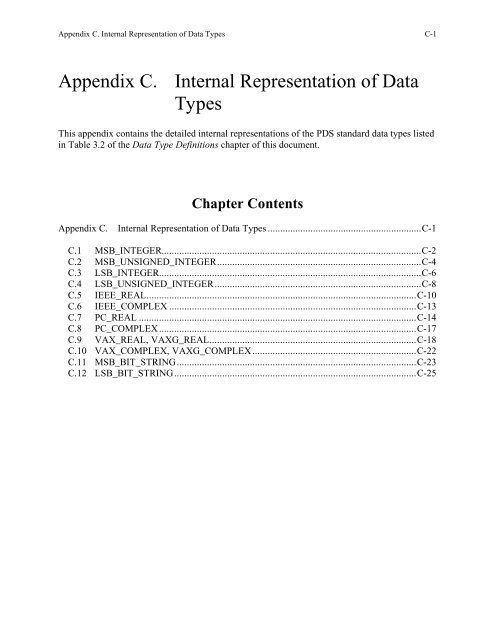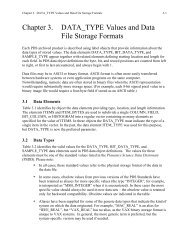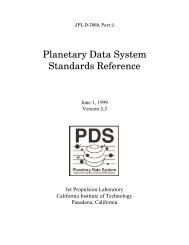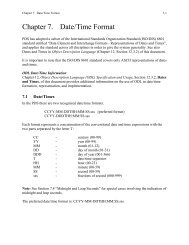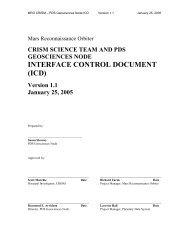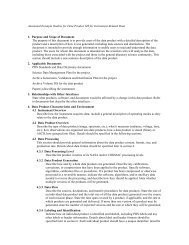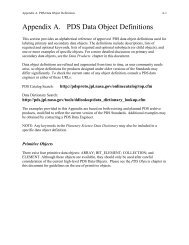Appendix C. Internal Representation of Data Types
Appendix C. Internal Representation of Data Types
Appendix C. Internal Representation of Data Types
You also want an ePaper? Increase the reach of your titles
YUMPU automatically turns print PDFs into web optimized ePapers that Google loves.
<strong>Appendix</strong> C. <strong>Internal</strong> <strong>Representation</strong> <strong>of</strong> <strong>Data</strong> <strong>Types</strong> C-1<br />
<strong>Appendix</strong> C. <strong>Internal</strong> <strong>Representation</strong> <strong>of</strong> <strong>Data</strong><br />
<strong>Types</strong><br />
This appendix contains the detailed internal representations <strong>of</strong> the PDS standard data types listed<br />
in Table 3.2 <strong>of</strong> the <strong>Data</strong> Type Definitions chapter <strong>of</strong> this document.<br />
Chapter Contents<br />
<strong>Appendix</strong> C. <strong>Internal</strong> <strong>Representation</strong> <strong>of</strong> <strong>Data</strong> <strong>Types</strong> .............................................................C-1<br />
C.1 MSB_INTEGER.......................................................................................................C-2<br />
C.2 MSB_UNSIGNED_INTEGER.................................................................................C-4<br />
C.3 LSB_INTEGER........................................................................................................C-6<br />
C.4 LSB_UNSIGNED_INTEGER..................................................................................C-8<br />
C.5 IEEE_REAL...........................................................................................................C-10<br />
C.6 IEEE_COMPLEX ..................................................................................................C-13<br />
C.7 PC_REAL ..............................................................................................................C-14<br />
C.8 PC_COMPLEX......................................................................................................C-17<br />
C.9 VAX_REAL, VAXG_REAL..................................................................................C-18<br />
C.10 VAX_COMPLEX, VAXG_COMPLEX.................................................................C-22<br />
C.11 MSB_BIT_STRING...............................................................................................C-23<br />
C.12 LSB_BIT_STRING................................................................................................C-25
C-2 <strong>Appendix</strong> C. <strong>Internal</strong> <strong>Representation</strong> <strong>of</strong> <strong>Data</strong> <strong>Types</strong><br />
C.1 MSB_INTEGER<br />
Aliases: INTEGER<br />
MAC_INTEGER<br />
SUN_INTEGER<br />
This section describes the signed integers stored in Most Significant Byte first (MSB) order. In<br />
this section the following definitions apply:<br />
b0 – b3<br />
i-sign<br />
i0 – i3<br />
Arrangement <strong>of</strong> bytes as they appear when read from a file (e.g., read b0<br />
first, then b1, b2, and b3)<br />
Integer sign bit (bit 7 in the highest-order byte<br />
Arrangement <strong>of</strong> bytes in the integer, from lowest order to highest order.<br />
The bits within each byte are interpreted from right to left (e.g., lowest<br />
value = bit 0, highest value = bit 7) in the following way:<br />
4-byte integers:<br />
In i0, bits 0-7 represent 2**0 through 2**7<br />
In i1, bits 0-7 represent 2**8 through 2**15<br />
In i2, bits 0-7 represent 2**16 through 2**23<br />
In i3, bits 0-6 represent 2**24 through 2**30<br />
2-byte integers:<br />
In i0, bits 0-7 represent 2**0 through 2**7<br />
In i1, bits 0-6 represent 2**8 through 2**14<br />
1-byte integers:<br />
In i0, bits 0-6 represent 2**0 through 2**6<br />
Negative integers are represented in two’s complement.<br />
C.1.1<br />
MSB 4-byte Integer
<strong>Appendix</strong> C. <strong>Internal</strong> <strong>Representation</strong> <strong>of</strong> <strong>Data</strong> <strong>Types</strong> C-3<br />
C.1.2<br />
MSB 2-byte Integer<br />
C.1.3<br />
MSB 1-byte Integer
C-4 <strong>Appendix</strong> C. <strong>Internal</strong> <strong>Representation</strong> <strong>of</strong> <strong>Data</strong> <strong>Types</strong><br />
C.2 MSB_UNSIGNED_INTEGER<br />
Aliases: UNSIGNED_INTEGER<br />
MAC_UNSIGNED_INTEGER<br />
SUN_UNSIGNED_INTEGER<br />
This section describes unsigned integers stored in Most Significant Byte first (MSB) format. In<br />
this section the following definitions apply:<br />
b0 – b3<br />
i0 – i3<br />
Arrangement <strong>of</strong> bytes as they appear when read from a file (e.g., read b0<br />
first, then b1, b2 and b3)<br />
Arrangement <strong>of</strong> bytes in the integer, from lowest order to highest order.<br />
The bits within each byte are interpreted from right to left (e.g., lowest<br />
value = bit 0, highest value = bit 7), in the following way:<br />
4-bytes:<br />
In i0, bits 0-7 represent 2**0 through 2**7<br />
In i1, bits 0-7 represent 2**8 through 2**15<br />
In i2, bits 0-7 represent 2**16 through 2**23<br />
In i3, bits 0-7 represent 2**24 through 2**31<br />
2-bytes:<br />
In i0, bits 0-7 represent 2**0 through 2**7<br />
In i1, bits 0-7 represent 2**8 through 2**15<br />
1-byte:<br />
In i0, bits 0-7 represent 2**0 through 2**7<br />
C.2.1<br />
MSB 4-byte Unsigned Integers
<strong>Appendix</strong> C. <strong>Internal</strong> <strong>Representation</strong> <strong>of</strong> <strong>Data</strong> <strong>Types</strong> C-5<br />
C.2.2<br />
MSB 2-byte Unsigned Integers<br />
C.2.3<br />
MSB 1-byte Unsigned Integers
C-6 <strong>Appendix</strong> C. <strong>Internal</strong> <strong>Representation</strong> <strong>of</strong> <strong>Data</strong> <strong>Types</strong><br />
C.3 LSB_INTEGER<br />
Aliases: PC_INTEGER<br />
VAX_INTEGER<br />
This section describes signed integers stored in Least Significant Byte first (LSB) order. In this<br />
section the following definitions apply:<br />
b0 – b3<br />
i-sign<br />
i0 – i3<br />
Arrangement <strong>of</strong> bytes as they appear when reading a file (e.g., read byte<br />
b0 first, then b1, b2 and b3)<br />
Integer sign bit – bit 7 in the highest order byte<br />
Arrangement <strong>of</strong> bytes in the integer, from lowest order to highest order.<br />
The bits within each byte are interpreted from right to left (e.g., lowest<br />
value = bit 0, highest value = bit 7), in the following way:<br />
4-bytes:<br />
In i0, bits 0-7 represent 2**0 through 2**7<br />
In i1, bits 0-7 represent 2**8 through 2**15<br />
In i2, bits 0-7 represent 2**16 through 2**23<br />
In i3, bits 0-6 represent 2**24 through 2**30<br />
2-bytes:<br />
In i0, bits 0-7 represent 2**0 through 2**7<br />
In i1, bits 0-6 represent 2**8 through 2**14<br />
1-byte:<br />
In i0, bits 0-6 represent 2**0 through 2**6<br />
All negative values are represented in two’s complement.<br />
C.3.1<br />
LSB 4-byte Integers
<strong>Appendix</strong> C. <strong>Internal</strong> <strong>Representation</strong> <strong>of</strong> <strong>Data</strong> <strong>Types</strong> C-7<br />
C.3.2<br />
LSB 2-byte Integers<br />
C.3.3<br />
LSB 1-byte Integers
C-8 <strong>Appendix</strong> C. <strong>Internal</strong> <strong>Representation</strong> <strong>of</strong> <strong>Data</strong> <strong>Types</strong><br />
C.4 LSB_UNSIGNED_INTEGER<br />
Aliases: PC_UNSIGNED_INTEGER<br />
VAX_UNSIGNED_INTEGER<br />
This section describes unsigned integers stored in Least Significant Byte first (LSB) format. In<br />
this section the following definitions apply:<br />
b0 – b3<br />
i0 – i3<br />
Arrangement <strong>of</strong> bytes as they appear when reading a file (e.g., read byte<br />
b0 first, then b1, b2 and b3)<br />
Arrangement <strong>of</strong> bytes in the integer, from lowest order to highest order.<br />
The bits within each byte are interpreted from right to left (e.g., lowest<br />
value = bit 0, highest value = bit 7), in the following way:<br />
4-bytes:<br />
In i0, bits 0-7 represent 2**0 through 2**7<br />
In i1, bits 0-7 represent 2**8 through 2**15<br />
In i2, bits 0-7 represent 2**16 through 2**23<br />
In i3, bits 0-7 represent 2**24 through 2**31<br />
2-bytes:<br />
In i0, bits 0-7 represent 2**0 through 2**7<br />
In i1, bits 0-7 represent 2**8 through 2**15<br />
1-byte:<br />
In i0, bits 0-7 represent 2**0 through 2**7<br />
C.4.1<br />
LSB 4-byte Unsigned Integers
<strong>Appendix</strong> C. <strong>Internal</strong> <strong>Representation</strong> <strong>of</strong> <strong>Data</strong> <strong>Types</strong> C-9<br />
C.4.2<br />
LSB 2-byte Unsigned Integers<br />
C.4.3<br />
LSB 1-byte Unsigned Integers
C-10 <strong>Appendix</strong> C. <strong>Internal</strong> <strong>Representation</strong> <strong>of</strong> <strong>Data</strong> <strong>Types</strong><br />
C.5 IEEE_REAL<br />
Aliases: FLOAT<br />
REAL<br />
MAC_REAL<br />
SUN_REAL<br />
This section describes the internal format <strong>of</strong> IEEE-format floating-point numbers. In this section<br />
the following definitions apply:<br />
b0 – b9<br />
m-sign<br />
int-bit<br />
e0 – e1<br />
Arrangement <strong>of</strong> bytes as they appear when read from a file (e.g., read b0<br />
first, then b1, b2, b3, etc.)<br />
Mantissa sign bit<br />
In 10-byte real format only, the integer part <strong>of</strong> the mantissa, assumed to be<br />
“1” in other formats, is explicitly indicated by this bit<br />
Arrangement <strong>of</strong> the portions <strong>of</strong> the bytes that make up the exponent, from<br />
lowest order to highest order. The bits within each byte are interpreted<br />
from right to left (e.g., lowest value = rightmost bit in the exponent part <strong>of</strong><br />
the byte, highest value = leftmost bit in the exponent part <strong>of</strong> the byte) in<br />
the following way:<br />
10-bytes (temporary):<br />
In e0, bits 0-7 represent 2**0 through 2**7<br />
In e1, bits 0-6 represent 2**8 through 2**14<br />
Exponent bias = 16383<br />
8-bytes (double precision):<br />
In e0, bits 4-7 represent 2**0 through 2**3<br />
In e1, bits 0-6 represent 2**4 through 2**10<br />
Exponent bias = 1023<br />
4-bytes (single precision):<br />
In e0, bit 7 represent 2**0<br />
In e1, bits 0-6 represent 2**1 through 2**7<br />
Exponent bias = 127
<strong>Appendix</strong> C. <strong>Internal</strong> <strong>Representation</strong> <strong>of</strong> <strong>Data</strong> <strong>Types</strong> C-11<br />
m0 – m7<br />
Arrangement <strong>of</strong> the portions <strong>of</strong> the bytes that make up the mantissa, from<br />
highest order fractions to the lowest order fraction. The order <strong>of</strong> the bits<br />
within each byte progresses from left to right, with each bit representing a<br />
fractional power <strong>of</strong> two, in the following way:<br />
10-bytes (temporary):<br />
In m0, bits 6-0 represent 1/2**1 through 1/2**7<br />
In m1, bits 7-0 represent 1/2**8 through 1/2**15<br />
In m2, bits 7-0 represent 1/2**16 through 1/2**23<br />
In m3, bits 7-0 represent 1/2**24 through 1/2**31<br />
In m4, bits 7-0 represent 1/2**32 through 1/2**39<br />
In m5, bits 7-0 represent 1/2**40 through 1/2**47<br />
In m6, bits 7-0 represent 1/2**48 through 1/2**55<br />
In m7, bits 7-0 represent 1/2**56 through 1/2**63<br />
8-bytes (double precision):<br />
In m0, bits 3-0 represent 1/2**1 through 1/2**4<br />
In m1, bits 7-0 represent 1/2**5 through 1/2**12<br />
In m2, bits 7-0 represent 1/2**13 through 1/2**20<br />
In m3, bits 7-0 represent 1/2**21 through 1/2**28<br />
In m4, bits 7-0 represent 1/2**29 through 1/2**36<br />
In m5, bits 7-0 represent 1/2**37 through 1/2**44<br />
In m6, bits 7-0 represent 1/2**45 through 1/2**52<br />
4-bytes (single precision):<br />
In m0, bits 6-0 represent 1/2**1 through 1/2**7<br />
In m1, bits 7-0 represent 1/2**8 through 1/2**15<br />
In m2, bits 7-0 represent 1/2**16 through 1/2**23<br />
The following representations all follow this format:<br />
1.mantissa 2**(exponent – bias)<br />
Note that the integer part (“1.”) is implicit in all formats except the 10-byte (temporary) real<br />
format, as described above. In all cases the exponent is stored as an unsigned, biased integer (that<br />
is, the stored exponent value – bias value = true exponent).
C-12 <strong>Appendix</strong> C. <strong>Internal</strong> <strong>Representation</strong> <strong>of</strong> <strong>Data</strong> <strong>Types</strong><br />
C.5.1<br />
IEEE 10-byte (Temporary) Real Numbers<br />
C.5.2<br />
IEEE 8-byte (Double Precision) Real Numbers<br />
C.5.3<br />
IEEE 4-byte (Single Precision) Real Numbers
<strong>Appendix</strong> C. <strong>Internal</strong> <strong>Representation</strong> <strong>of</strong> <strong>Data</strong> <strong>Types</strong> C-13<br />
C.6 IEEE_COMPLEX<br />
Aliases: COMPLEX<br />
MAC_COMPLEX<br />
SUN_COMPLEX<br />
IEEE complex numbers consist <strong>of</strong> two IEEE_REAL format numbers <strong>of</strong> the same precision,<br />
contiguous in memory. The first number represents the real part and the second the imaginary<br />
part <strong>of</strong> the complex value.<br />
For more information on using IEEE_REAL formats, see Section C.5.
C-14 <strong>Appendix</strong> C. <strong>Internal</strong> <strong>Representation</strong> <strong>of</strong> <strong>Data</strong> <strong>Types</strong><br />
C.7 PC_REAL<br />
Aliases: None<br />
This section describes the internal storage format corresponding to the PC_REAL data type. In<br />
this section the following definitions apply:<br />
b0 – b9<br />
m-sign<br />
int-bit<br />
e0 – e1<br />
Arrangement <strong>of</strong> bytes as they appear when read from a file (e.g., read b0<br />
first, then b1, b2 and b3)<br />
Mantissa sign bit<br />
In 10-byte real format only, the integer part <strong>of</strong> the mantissa, assumed to be<br />
“1” in other formats, is explicitly indicated by this bit.<br />
Arrangement <strong>of</strong> the portions <strong>of</strong> the bytes that make up the exponent, from<br />
lowest order to highest order. The bits within each byte are interpreted<br />
from right to left (e.g., lowest value = rightmost bit in the exponent part <strong>of</strong><br />
the byte, highest value = leftmost bit in the exponent part <strong>of</strong> the byte) in<br />
the following way:<br />
10-bytes (temporary):<br />
In e0, bits 0-7 represent 2**0 through 2**7<br />
In e1, bits 0-6 represent 2**8 through 2**14<br />
Exponent bias = 16383<br />
8-bytes (double precision):<br />
In e0, bits 4-7 represent 2**0 through 2**3<br />
In e1, bits 0-6 represent 2**4 through 2**10<br />
Exponent bias = 1023<br />
4-bytes (single precision):<br />
In e0, bit 7 represent 2**0<br />
In e1, bits 0-6 represent 2**1 through 2**7<br />
Exponent bias = 127<br />
m0 – m7<br />
Arrangement <strong>of</strong> the portions <strong>of</strong> the bytes that make up the mantissa, from<br />
highest order fractions to the lowest order fraction. The order <strong>of</strong> the bits<br />
within each byte progresses from left to right, with each bit representing a<br />
fractional power <strong>of</strong> two, in the following way:<br />
10-bytes (temporary):
<strong>Appendix</strong> C. <strong>Internal</strong> <strong>Representation</strong> <strong>of</strong> <strong>Data</strong> <strong>Types</strong> C-15<br />
In m0, bits 6-0 represent 1/2**1 through 1/2**7<br />
In m1, bits 7-0 represent 1/2**8 through 1/2**15<br />
In m2, bits 7-0 represent 1/2**16 through 1/2**23<br />
In m3, bits 7-0 represent 1/2**24 through 1/2**31<br />
In m4, bits 7-0 represent 1/2**32 through 1/2**39<br />
In m5, bits 7-0 represent 1/2**40 through 1/2**47<br />
In m6, bits 7-0 represent 1/2**48 through 1/2**55<br />
In m7, bits 7-0 represent 1/2**56 through 1/2**63<br />
8-bytes (double precision):<br />
In m0, bits 3-0 represent 1/2**1 through 1/2**4<br />
In m1, bits 7-0 represent 1/2**5 through 1/2**12<br />
In m2, bits 7-0 represent 1/2**13 through 1/2**20<br />
In m3, bits 7-0 represent 1/2**21 through 1/2**28<br />
In m4, bits 7-0 represent 1/2**29 through 1/2**36<br />
In m5, bits 7-0 represent 1/2**37 through 1/2**44<br />
In m6, bits 7-0 represent 1/2**45 through 1/2**52<br />
4-bytes (single precision):<br />
In m0, bits 6-0 represent 1/2**1 through 1/2**7<br />
In m1, bits 7-0 represent 1/2**8 through 1/2**15<br />
In m2, bits 7-0 represent 1/2**16 through 1/2**23<br />
The following representations all follow this format:<br />
1.mantissa 2**(exponent – bias)<br />
Note that the integer part (“1.”) is implicit in all formats except the 10-byte (temporary) real<br />
format, as described above. In all cases the exponent is stored as an unsigned, biased integer (that<br />
is, the stored exponent value – bias value = true exponent).
C-16 <strong>Appendix</strong> C. <strong>Internal</strong> <strong>Representation</strong> <strong>of</strong> <strong>Data</strong> <strong>Types</strong><br />
C.7.1<br />
PC 10-byte (Temporary) Real Numbers<br />
C.7.2<br />
PC 8-byte (Double Precision) Real Numbers<br />
C.7.3<br />
PC 4-byte (Single Precision) Real Numbers
<strong>Appendix</strong> C. <strong>Internal</strong> <strong>Representation</strong> <strong>of</strong> <strong>Data</strong> <strong>Types</strong> C-17<br />
C.8 PC_COMPLEX<br />
Aliases: None<br />
PC complex numbers consist <strong>of</strong> two PC_REAL format numbers <strong>of</strong> the same precision,<br />
contiguous in memory. The first number represents the real part and the second the imaginary<br />
part <strong>of</strong> the complex value.<br />
For more information on using PC_REAL formats, see Section C.7.
C-18 <strong>Appendix</strong> C. <strong>Internal</strong> <strong>Representation</strong> <strong>of</strong> <strong>Data</strong> <strong>Types</strong><br />
C.9 VAX_REAL, VAXG_REAL<br />
Aliases: VAX_DOUBLE for VAX_REAL only.<br />
No aliases for VAXG_REAL<br />
This section describes the internal format corresponding to the VAX_REAL and VAXG_REAL<br />
data types. In this section the following definitions apply:<br />
b0 – b15<br />
m-sign<br />
e0 – e1<br />
Arrangement <strong>of</strong> bytes as they appear when read from a file (e.g., read b0<br />
first, then b1, b2 and b3)<br />
Mantissa sign bit<br />
Arrangement <strong>of</strong> the portions <strong>of</strong> the bytes that make up the exponent, from<br />
lowest order to highest order. The bits within each byte are interpreted<br />
from right to left (e.g., lowest value = rightmost bit in the exponent part <strong>of</strong><br />
the byte, highest value = leftmost bit in the exponent part <strong>of</strong> the byte) in<br />
the following way:<br />
16-bytes (H-type, quad precision):<br />
In e0, bits 0-7 represent 2**0 through 2**7<br />
In e1, bits 0-6 represent 2**8 through 2**14<br />
Exponent bias = 16385<br />
8-bytes (G-type, double precision):<br />
In e0, bits 4-7 represent 2**0 through 2**3<br />
In e1, bits 0-6 represent 2**4 through 2**10<br />
Exponent bias = 1025<br />
8-bytes (D-type, double precision):<br />
In e0, bit 7 represents 2**0<br />
In e1, bits 0-6 represent 2**1 through 2**7<br />
Exponent bias = 129<br />
4-bytes (F-type, single precision):<br />
In e0, bit 7 represent 2**0<br />
In e1, bits 0-6 represent 2**1 through 2**7<br />
Exponent bias = 129
<strong>Appendix</strong> C. <strong>Internal</strong> <strong>Representation</strong> <strong>of</strong> <strong>Data</strong> <strong>Types</strong> C-19<br />
m0 – m13<br />
Arrangement <strong>of</strong> the portions <strong>of</strong> the bytes that make up the mantissa, from<br />
highest order fractions to the lowest order fraction. The order <strong>of</strong> the bits<br />
within each byte progresses from left to right, with each bit representing a<br />
fractional power <strong>of</strong> two, in the following way:<br />
16-bytes (H-type, quad precision):<br />
In m0, bits 7-0 represent 1/2**1 through 1/2**8<br />
In m1, bits 7-0 represent 1/2**9 through 1/2**16<br />
In m2, bits 7-0 represent 1/2**17 through 1/2**24<br />
In m3, bits 7-0 represent 1/2**25 through 1/2**32<br />
In m4, bits 7-0 represent 1/2**33 through 1/2**40<br />
In m5, bits 7-0 represent 1/2**41 through 1/2**48<br />
In m6, bits 7-0 represent 1/2**49 through 1/2**56<br />
In m7, bits 7-0 represent 1/2**57 through 1/2**64<br />
In m8, bits 7-0 represent 1/2**65 through 1/2**72<br />
In m9, bits 7-0 represent 1/2**73 through 1/2**80<br />
In m10, bits 7-0 represent 1/2**81 through 1/2**88<br />
In m11, bits 7-0 represent 1/2**89 through 1/2**96<br />
In m12, bits 7-0 represent 1/2**97 through 1/2**104<br />
In m13, bits 7-0 represent 1/2**105 through 1/2**112<br />
8-bytes (G-type, double precision):<br />
In m0, bits 3-0 represent 1/2**1 through 1/2**4<br />
In m1, bits 7-0 represent 1/2**5 through 1/2**12<br />
In m2, bits 7-0 represent 1/2**13 through 1/2**20<br />
In m3, bits 7-0 represent 1/2**21 through 1/2**28<br />
In m4, bits 7-0 represent 1/2**29 through 1/2**36<br />
In m5, bits 7-0 represent 1/2**37 through 1/2**44<br />
In m6, bits 7-0 represent 1/2**45 through 1/2**52<br />
8-bytes (D-type, double precision):<br />
In m0, bits 6-0 represent 1/2**1 through 1/2**7<br />
In m1, bits 7-0 represent 1/2**8 through 1/2**15<br />
In m2, bits 7-0 represent 1/2**16 through 1/2**23<br />
In m3, bits 7-0 represent 1/2**24 through 1/2**31<br />
In m4, bits 7-0 represent 1/2**32 through 1/2**39<br />
In m5, bits 7-0 represent 1/2**40 through 1/2**47<br />
In m6, bits 7-0 represent 1/2**48 through 1/2**55<br />
4-bytes (F-type, single precision):<br />
In m0, bits 6-0 represent 1/2**1 through 1/2**7<br />
In m1, bits 7-0 represent 1/2**8 through 1/2**15<br />
In m2, bits 7-0 represent 1/2**16 through 1/2**23
C-20 <strong>Appendix</strong> C. <strong>Internal</strong> <strong>Representation</strong> <strong>of</strong> <strong>Data</strong> <strong>Types</strong><br />
The following representations all follow this format:<br />
1.mantissa 2**(exponent – bias)<br />
Note that the integer part (“1.”) is implicit in all formats except the 10-byte (temporary) real<br />
format, as described above. In all cases the exponent is stored as an unsigned, biased integer (that<br />
is, the stored exponent value – bias value = true exponent).<br />
C.9.1<br />
VAX 16-byte H-type (Quad Precision) Real Numbers<br />
C.9.2<br />
VAX 8-byte G-type (Double Precision) Real Numbers
<strong>Appendix</strong> C. <strong>Internal</strong> <strong>Representation</strong> <strong>of</strong> <strong>Data</strong> <strong>Types</strong> C-21<br />
C.9.3<br />
VAX 8-byte D-type (Double Precision) Real Numbers<br />
C.9.4<br />
VAX 4-byte F-type (Single Precision) Real Numbers
C-22 <strong>Appendix</strong> C. <strong>Internal</strong> <strong>Representation</strong> <strong>of</strong> <strong>Data</strong> <strong>Types</strong><br />
C.10 VAX_COMPLEX, VAXG_COMPLEX<br />
Aliases: None<br />
VAX complex numbers consist <strong>of</strong> two VAX_REAL (or VAXG_REAL) format numbers <strong>of</strong> the<br />
same precision, contiguous in memory. The first number represents the real part and the second<br />
the imaginary part <strong>of</strong> the complex value.<br />
For more information on using VAX_REAL formats, see Section C.9.
<strong>Appendix</strong> C. <strong>Internal</strong> <strong>Representation</strong> <strong>of</strong> <strong>Data</strong> <strong>Types</strong> C-23<br />
C.11 MSB_BIT_STRING<br />
Aliases: None<br />
This section describes the storage format for bit strings stored in Most Significant Byte first<br />
(MSB) format. In this section the following definitions apply:<br />
b0 – b3<br />
Arrangement <strong>of</strong> bytes as they appear when read from a file (e.g., read b0<br />
first, then b1, b2 and b3)<br />
The bits within a byte are numbered from left to right, as shown below:<br />
Note that in the case <strong>of</strong> MSB bit strings, no byte-swapping is required. That is, the physical<br />
storage order <strong>of</strong> the bytes is identical to the logical order.<br />
C.11.1 MSB n-byte Bit Strings<br />
C.11.2 MSB 2-byte Bit String
C-24 <strong>Appendix</strong> C. <strong>Internal</strong> <strong>Representation</strong> <strong>of</strong> <strong>Data</strong> <strong>Types</strong><br />
C.11.3 MSB 1-byte Bit String
<strong>Appendix</strong> C. <strong>Internal</strong> <strong>Representation</strong> <strong>of</strong> <strong>Data</strong> <strong>Types</strong> C-25<br />
C.12 LSB_BIT_STRING<br />
Aliases: VAX_BIT_STRING<br />
This section describes the structure <strong>of</strong> bit strings stored in Least Significant Byte first (LSB)<br />
order. In this section, the following definitions apply:<br />
b0 – b3<br />
Arrangement <strong>of</strong> bytes as they appear when read from a file (e.g., read b0<br />
first, then b1, b2 and b3)<br />
The bits within a byte are numbered from left to right, as shown below:<br />
Note that for LSB bit strings byte-swapping is required to convert the storage order <strong>of</strong> bytes to<br />
the logical order.<br />
C.12.1 LSB 4-byte Bit String<br />
Physical order (as read from the file):<br />
Logical order (after byte-swapping):
C-26 <strong>Appendix</strong> C. <strong>Internal</strong> <strong>Representation</strong> <strong>of</strong> <strong>Data</strong> <strong>Types</strong><br />
C.12.2 LSB 2-byte Bit String<br />
Physical order (as read from the file):<br />
Logical order (after byte-swapping):<br />
C.12.3 LSB 1-byte Bit String<br />
Note that in this degenerate case no byte-swapping is required.
<strong>Appendix</strong> C. <strong>Internal</strong> <strong>Representation</strong> <strong>of</strong> <strong>Data</strong> <strong>Types</strong> C-27<br />
binary storage formats, C-1<br />
, C-1<br />
data representation<br />
internal, C-1<br />
IEEE_COMPLEX<br />
storage format, C-13<br />
IEEE_REAL<br />
storage format, C-10<br />
least significant byte first (LSB) storage format, C-6, C-8, C-25<br />
LSB_BIT_STRING<br />
storage format, C-25<br />
LSB_INTEGER<br />
storage format, C-6<br />
LSB_UNSIGNED_INTEGER<br />
storage format, C-8<br />
most significant byte first (MSB) storage format, C-2, C-4, C-23<br />
MSB_BIT_STRING<br />
storage format, C-23<br />
MSB_INTEGER<br />
storage format, C-2<br />
MSB_UNSIGNED_INTEGER<br />
storage format, C-4<br />
PC_COMPLEX<br />
storage format, C-17<br />
PC_REAL<br />
storage format, C-14<br />
, C-1<br />
, C-1<br />
, C-1<br />
, C-1<br />
, C-1<br />
, C-1<br />
, C-1<br />
VAX_COMPLEX<br />
storage format, C-22<br />
VAX_REAL
C-2 <strong>Appendix</strong> C. <strong>Internal</strong> <strong>Representation</strong> <strong>of</strong> <strong>Data</strong> <strong>Types</strong><br />
storage format, C-18<br />
VAXG_COMPLEX<br />
storage format, C-22<br />
VAXG_REAL<br />
storage format, C-18


